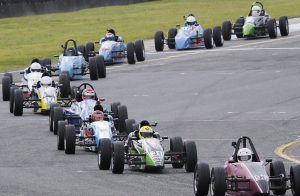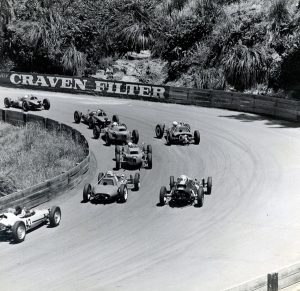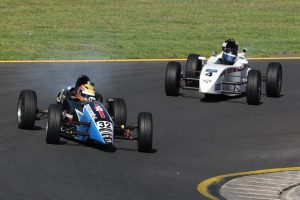 You’ve been watching your motor racing heroes like Craig Lowndes, Mark Webber, Peter Brock, Lewis Hamilton and Fernando Alonso on TV for as long as you can remember. You’ve been lying in bed and reading about Formula 1, about V8s, and about apexes, understeer, oversteer, brake balance etc.
You’ve been watching your motor racing heroes like Craig Lowndes, Mark Webber, Peter Brock, Lewis Hamilton and Fernando Alonso on TV for as long as you can remember. You’ve been lying in bed and reading about Formula 1, about V8s, and about apexes, understeer, oversteer, brake balance etc.
“I can do better than all of them! Webber couldn’t pass a car if they moved over and waved him through!” Or maybe you’ve been racing karts since you were 8 years old, and now that you are 14 its time to think of making the first big move into real racing cars – real racing cars like Formula Vee!
The time has come to take the plunge, to fulfil your dreams – to become a RACING CAR DRIVER!
Formula Vee Racing provides the thrill of fiercely competitive motor racing at a budget cost. Permitted modifications are minimal so that greater emphasis is on driver skill rather than budget. As a result, the class is the first proving ground in motor racing and has always been a stepping stone to higher levels of motorsport.
Current Australian motorsport young guns, Matthew McLean, Cameron Waters, Jack LeBrocq, Caleb Rayner and Sam Power starting their circuit career in Formula Vee. Racing greats like Cameron McConville, Larry Perkins, Jason Bargwanna, Colin Bond, John Blanchard and John Bowe also began their careers in Formula Vee. On the international stage, Niki Lauda, Emerson Fittipaldi and Keke Rosberg, all Formula 1 champions, raced Formula Vees in Europe or America at the beginning of their careers.
The Class
 When Formula Vee was established it was designed as a learning class of motor racing. As the sport grew, the formula quickly established itself as a popular form of racing world-wide. Take a look at Formula Vee at the 33rd Australian Grand Prix held in 1968.
When Formula Vee was established it was designed as a learning class of motor racing. As the sport grew, the formula quickly established itself as a popular form of racing world-wide. Take a look at Formula Vee at the 33rd Australian Grand Prix held in 1968.
Formula Vee was established in Australia in 1965. Membership and car clubs have grown rapidly as it is a level of motor racing most enthusiasts can afford. It is the best value-for-money race car package in Australia.
Formula Vee racing provides the thrill of fiercely competitive motor racing at a budget cost. Permitted modifications are minimal so that greater emphasis is on driver skill rather than budget. As a result, the class is the first proving ground in motor racing and has always been a stepping stone to higher levels of motorsport.
Formula Vee is controlled by the Formula Vee Association of Australia (FVAA). Without any support from the motor sports establishment, Formula Vee is the fastest growing category with the largest pool of cars in Australian motor sport.
Vee History
 The class originated in the U.S. in 1960 at the request of a Volkswagen dealer. Vee racing began in 1963 and was recognised as a class of racing by the Sports Car Club of America. Within a year it was rated fourth in numbers in the 17 racing classes, a year later it was a close second and by 1966 the class was way out in front.
The class originated in the U.S. in 1960 at the request of a Volkswagen dealer. Vee racing began in 1963 and was recognised as a class of racing by the Sports Car Club of America. Within a year it was rated fourth in numbers in the 17 racing classes, a year later it was a close second and by 1966 the class was way out in front.
In Australia, Formula Vee was established in 1965. Up until 2004, Formula Vees in Australia where based in the 1200cc Volkswagen engine, gearbox and suspension. After much research and consultation, the Australian Formula Vee community began its shift towards the Volkswagen 1600cc engine, gearbox and suspension. Today, Formula Vee looks modern, are easy to work on and parts are plentiful.
Racing a Formula Vee
Formula Vee is the most affordable open wheel racing car category in Australia. It represents the ultimate in simple but effective technology in an affordable race car package.
In the sport of motor racing, where the cost of a car in most categories is in excess of $95,000, the cost of a new Formula Vee (1600cc) is about $55,000 and you can expect to pay around $20,000 for a competitive second hand 1600cc car. 1200cc cars range from between $5,000 and $10,000. Running costs are low, the VW engine and the VW components are most reliable, available locally and easy to maintain – and a Vee car remains competitive for many years.
A feature of Formula Vee racing is the drivers hitting 200 kph along the straights and then keeping the cars ‘on the edge’ for the whole race in tight formations. The strong VW engine can take revs of up to 6,500RPM.
Vee cars race hard and close together with frequent lead changes and close finishes. Lap times are only slightly below those of much more powerful cars. Formula Vee is found on every racing circuit in Australia with sometimes over 40 cars in an event.
The chassis are simple and easy to repair with costs minimal. Despite the often intense wheel-to-wheel racing there have been few accidents. Formula Vee has an excellent safety record with only very few serious injuries. Due to the structural integrity of the cars drivers generally walk away unharmed from appealing and ageless form of motor racing. Drivers from 14 to 65 compete in evenly matched cars that emphasise driver skill.
Formula Vee Specifications
A standard 1200cc or 1600cc air cooled VW engine with a standard 4 speed Volkswagen gearbox, and VW components in front and rear suspension. The engine is straightforward to remove and dismantle. The chassis are simple and body panels are either aluminium or fibre glass and easy to repair.
All up body weight of the car and driver is restricted to a minimum of 485kg for 1200cc cars and 500kg for 1600cc cars, with a top speed of approximately 200 km/h.
| Engine | 1200cc or 1600cc standard Volkswagen engine. No modifications permitted other than those stipulated in the rules. Approximately 50 HP produced. |
| Gearbox | Standard Volkswagen (VW 1200, 1300 or 1500 gearboxes permitted). Mounted 180 degree about for better weight distribution. |
| Front Suspension | Volkswagen Type 1 H-Beam with some modifications. |
| Rear Suspension | Free, provided standard Volkswagen axle tubes are used. |
| Wheels | Minimum weight and size restrictions |
| Tyres | Control racing compound tyre. Tyres are all weather & unidirectional. |
| Top Speed | Approximately 200 km/h |
| Minimum Car Weight | 485kg(1200cc) / 500kg(1600cc) including driver. |
| Cost | New 1600cc spec car costs around $55,000. Second hand competitive 1600cc costs around $20,000. Second hand 1200cc cars cost between $5,000 and $10,000 |